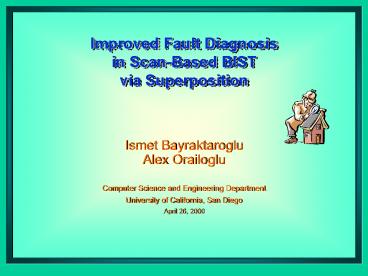Improved Fault Diagnosis in ScanBased BIST via Superposition
1 / 15
Title:
Improved Fault Diagnosis in ScanBased BIST via Superposition
Description:
Diagnosis information hidden in test signature ... as a percentile of scan size. 15. Conclusions. Diagnosis of Scan-Based BIST is challenging ... –
Number of Views:23
Avg rating:3.0/5.0
Title: Improved Fault Diagnosis in ScanBased BIST via Superposition
1
Improved Fault Diagnosis in Scan-Based BIST via
Superposition
Ismet Bayraktaroglu Alex Orailoglu Computer
Science and Engineering Department University of
California, San Diego April 26, 2000
2
Outline
- Diagnosis in Scan BIST
- Failing Scan Cell Determination
- Partitioning Approach
- Improvements via Superposition
- Experimental Results
- Dynamic Partitioning
- Conclusions
3
Diagnosis in Scan BIST
P R P G
M I S R
Circuit Under Test
- Outputs of individual test patterns are not
available - Only a compact signature is available
- Diagnosis information hidden in test signature
- Can be revealed through extensive fault
simulations - May be ineffective in case of signature aliasing
and unmodeled faults - Determination of failing scan cells helps
- Localize fault sites
4
Failing Scan Cell Determination
- A single signature for the whole scan chain
- Does not provide any diagnosis information
- Individual observation of scan chains
- Requires N applications of the same test
- Partitioned observation of scan chain
- Reduced test application
5
Partitioning Example
- 16 scan cells partitioned into 4 partitions,
called a test group
Scan chain
Potentially Faulty Cell List
- How many partitions?
- How to generate the partitions?
- Non-overlapping partitions within a group
- Minimal overlap among different groups
- Deterministic vs. Random partitioning
- Deterministic partitioning requires high overhead
- Pseudo-random partitioning is possible with low
hardware cost
6
Pseudo-Random Partitioning
11010101011 010 10001101010 101 00111101001
011 01111010010 110 11110100101 100 11001110111
001 10111010010 011 01010011000 111 10100110001
110 01101011111 101 11010111111 010 10001000010
101 00110111001 011 01101110010 110 11011100101
100 10011110111 001
- LFSR state is compared to partition counter
- At the end of each test session, LFSR is
initialized with IVR - At the end of a test group, IVR is set to current
state of LFSR
7
Improvements via Superposition
Scan chain
Potentially Faulty Cell List
- Only pass/fail information is utilized
- Signature content contains extra information
- Superposition
- Superposition of two signatures results in the
signature of the cells that are included in only
one of the two partitions
8
Improvements via Superposition
Partitions
Potentially faulty cell list
Without superposition, three test groups are
required
With superposition, two test groups are enough
9
Superposition
Performed by software no additional hardware
requirements Si Signature for scan cell Ci
P1(1)
P1(2)
P1(N)
...
P1 (CP1(1), CP1(2), , CP1(N))
...
P2 (CP2(1), CP2(2), , CP2(N))
P2(1)
P2(2)
P2(N)
SP1P2 SP1(1) ? SP1(2) ? ? SP1(N) ? SP2(1) ?
SP2(2) ? ? SP2(N)
- No extra information is attained unless failing
cells cancel - Superposition is not limited to single cell
cancellation
10
Experimental Results
Scan size 5000 cells
Diagnosis time as a percentile of scan size
Number of failing cells
Number of failing cells
Without Superposition
With Superposition
- Diagnosis time is reduced by more than 50
- Discontinuities due to partition size increments
show up as choppy behavior on simulation results
on the right
11
Diagnosis Time Improvement
Number of failing cells
Number of failing cells
Diagnosis Time Ratio
Ratio for Optimum Partition Size
- Improvement levels vary with the number of
partitions and failing scan cells - Use of superposed partitions helps reduce
diagnosis time by more than 55.
12
Dependence on Failing Cell Count
- Underestimating failures
- Increases diagnosis time almost exponentially
- Overestimating failures
- Increases diagnosis time, but not as drastically
- Attaining optimum diagnosis time necessitates
- Advance knowledge of the number of failing cells
- Near-optimum values can be attained by
- Starting with a small number of partitions
- Increasing number of partitions as diagnosis
progresses
13
Dynamic Partitioning Hardware
- The number of partitions is adjusted by the
number ofbits compared - Partition counter is reset depending on the
currentnumber of partitions
14
Dynamic Partitioning Results
Diagnosis time as a percentile of scan size
Number of failing cells
- Near-optimum diagnosis time is attained
- With no knowledge of the number of failing cells
- Only a small area overhead is incurred
15
Conclusions
- Diagnosis of Scan-Based BIST is challenging
- Partitioning based elimination technique provides
low-cost diagnostic procedures - Utilization of the superposition principle
improves diagnosis times - Adjusting the number of partitions dynamically
results in near-optimum diagnosis time































